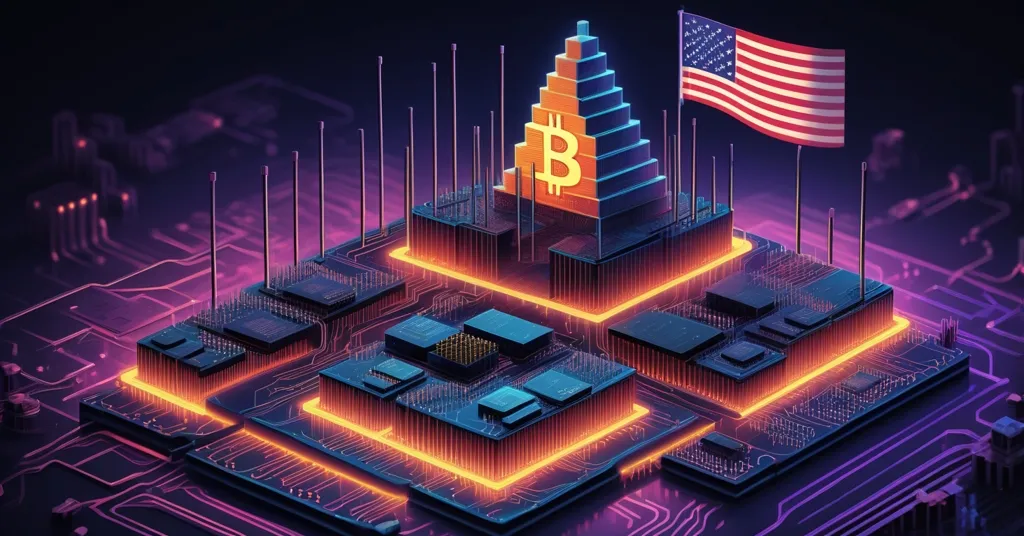Intel Stock Jumps 7% on Trump Stake Rumors: Crypto Mining Impact in Focus

Intel Stock Surges 7% as Trump Administration Eyes Stake: A Crypto Crossroads?
Intel, once the unchallenged king of American semiconductors, watched its stock climb 7% on August 14, 2025, following a Bloomberg bombshell that the Trump administration is considering a federal equity stake to rescue its struggling chip manufacturing. This isn’t just a tech story—it’s a potential game-changer for national security, U.S. tech dominance, and even the cryptocurrency mining ecosystem we care so deeply about.
- Stock Spike: Intel shares jumped 7-8% on stake rumors, with after-hours gains signaling market intrigue.
- Government Move: Trump’s team aims to bolster Intel’s domestic production, targeting delayed projects like Ohio facilities.
- Deep Challenges: A $2.9 billion Q2 loss and AI chip failures reveal Intel’s core struggles, government lifeline or not.
Intel’s Decline: From Titan to Trouble
Let’s rewind. Intel was once synonymous with computing power, dominating the PC era with chips that powered everything from corporate servers to your clunky childhood desktop. But the company missed critical turns—failing to pivot into mobile chips when smartphones exploded and stumbling in the race for AI hardware, where Nvidia now reigns supreme. Fast forward to 2025, and Intel is bleeding red ink, posting a $2.9 billion loss in just three months of Q2—a sign it’s burning cash faster than it can earn. Projects like new factories in Ohio are delayed and scaled back, while plans for facilities in Germany and Poland have been outright scrapped due to financial strain. Last year saw its stock plummet 60%, one of the worst in its history, though a 19% rebound in 2025 offers a flicker of hope. This isn’t just a company in crisis; it’s a national asset on the brink.
Why does this matter? Semiconductors are the heartbeat of modern tech, from your laptop to military drones. For us in the crypto space, they’re the muscle behind Bitcoin mining rigs and the servers running blockchain networks. Intel’s decline isn’t just a corporate sob story—it’s a crack in the foundation of U.S. technological independence, especially when foreign giants like TSMC (Taiwan Semiconductor Manufacturing Company) and Samsung dominate advanced chip production, even with facilities on American soil. To understand Intel’s pivotal role, check out its history in the semiconductor industry.
Trump’s Play: A Lifeline with Strings?
Enter the Trump administration, swinging a potential equity stake like a financial sledgehammer to keep Intel—and by extension, advanced chip production—firmly American. The goal is clear: ensure the U.S. doesn’t rely on foreign manufacturers for critical tech, a vulnerability exposed by global supply chain chaos and tensions with China. Intel’s Ohio manufacturing hub, meant to be a flagship for domestic production, is a focal point for this proposed funding, despite its delays and downsizing. As the only major U.S. company capable of producing cutting-edge processors at home, Intel is seen as a linchpin for national security and economic strength. More on this can be found in reports about the Trump administration’s national security focus on Intel.
But this isn’t a simple rescue mission. President Trump hasn’t held back, publicly slamming Intel CEO Lip-Bu Tan on Truth Social over alleged ties to Chinese tech investments, even demanding his resignation. It’s a brutal opening salvo for negotiations, yet Tan was at the White House discussing the deal, as confirmed by the Wall Street Journal. Intel has defended its leader, pushing back against the criticism while carefully navigating the political minefield. For a detailed fact-check on these allegations, see this analysis of Tan’s past Chinese tech ties.
“[Tan is] deeply committed to advancing U.S. national and economic security interests.” – Intel’s defense of CEO Lip-Bu Tan against Trump’s sharp attacks.
“We look forward to continuing our work with the Trump administration to advance these shared priorities, but we are not going to comment on rumors or speculation.” – Intel spokesperson on the potential equity stake.
“Intel is deeply committed to supporting President Trump’s efforts to strengthen U.S. technology and manufacturing leadership.” – Intel’s statement on collaboration with Trump, dodging specifics on the deal.
This feud isn’t just personal drama; it’s rooted in the U.S.-China tech rivalry. Tan’s past investments in Chinese firms linked to military interests and violations tied to sensitive tech during his time at Cadence Design Systems (per U.S. Justice Department records) have raised eyebrows. Analyst Patrick Moorhead of Moor Insights & Strategy suggests Trump’s outbursts might be tactical, pressuring Intel on unrelated U.S. investment promises or even partnerships with rivals like TSMC. It’s a high-stakes chess game, played out in public view, as detailed in this Bloomberg report on the potential stake.
Trump’s interventionist streak isn’t new. His administration has already taken a $400 million stake in rare-earth miner MP Materials, slapped export restrictions on chipmakers like Nvidia and AMD, and secured a “golden share” in U.S. Steel’s acquisition by Nippon Steel to retain control. This pattern of prioritizing national dominance over free-market purity might chafe decentralization purists like us, but it’s hard to ignore when critical industries hang in the balance. Community discussions on platforms like Reddit highlight diverse opinions on this move.
Semiconductors: The Backbone of Tech and Crypto
Beyond boardroom battles, semiconductors are the unsung heroes of our digital world. They power everything from smartphones to missile guidance systems, making their production a matter of strategic urgency. The U.S. has lagged behind foreign competitors like TSMC in crafting the smallest, most advanced chips—think 3-nanometer tech, the cutting edge of efficiency and speed. Global supply crunches, like those in 2020-2021, exposed how reliant America is on overseas factories, a risk amplified by geopolitical spats with China. For the Trump administration, propping up Intel isn’t just about jobs; it’s about ensuring the nation’s tech backbone isn’t held hostage by foreign powers.
Now, let’s bring this home to our world. Bitcoin mining, Ethereum’s network nodes, and the high-performance computing behind decentralized apps all depend on advanced chips. Miners use specialized hardware called ASICs (Application-Specific Integrated Circuits), essentially machines built for one purpose—crunching numbers to secure the Bitcoin blockchain. Altcoin projects like Solana, with its lightning-fast transactions, or Polkadot, enabling blockchain interoperability, also lean on powerful semiconductors for their infrastructure. When Intel struggles, or when supply chains snag on international tensions, the ripple hits us—think skyrocketing costs for mining rigs or delays in getting hardware to keep networks humming. This connection is explored further in discussions on Intel’s impact on Bitcoin mining hardware supply.
Crypto Implications: A Double-Edged Sword
Here’s where Intel’s fate gets personal for crypto enthusiasts. U.S.-listed Bitcoin miners like Riot Platforms and Marathon Digital often rely on imported ASIC miners from companies like Bitmain and MicroBT, both based in China. Geopolitical flare-ups—tariffs, export bans, or outright supply halts—can jack up costs or grind operations to a halt. A revitalized Intel, backed by government muscle, could stabilize domestic production of chips or even spur U.S.-made mining hardware, cutting reliance on foreign manufacturers and potentially slashing costs for miners. Imagine cheaper, more accessible rigs fueling Bitcoin adoption stateside—a win for decentralization’s grassroots growth.
Altcoin ecosystems stand to gain too. Ethereum’s layer-2 scaling solutions, which boost transaction speed and cut fees, need robust computing power, as do high-throughput chains like Solana. A stronger Intel could indirectly support these innovations by ensuring a steady chip supply for developers and node operators. Even AI-focused tokens like Fetch.ai or Render, often tied to tech market sentiment, might see short-term boosts if Intel’s revival lifts broader confidence in U.S. hardware. Market reactions to this news are already making waves, with reports of Intel’s stock climbing 7% on these rumors.
The Dark Side: Is This a Boondoggle in Disguise?
Let’s play devil’s advocate and tear into this with a no-BS lens. Intel’s problems aren’t just financial—they’re systemic. Failing to keep pace with Nvidia in AI chips, botching its foundry business (manufacturing for other companies), and dragging its feet on projects signal a company that might not be saved by a government check. Throwing taxpayer money at a broken machine risks turning Intel into a black hole of federal funds, especially when its stock volatility—down 60% in 2024, up 19% in 2025, with conflicting 3% drops amid Trump’s rants—screams uncertainty. Historical flops of state-backed tech initiatives, like the Solyndra solar debacle, loom as a warning: good intentions don’t guarantee results.
Then there’s the centralization stink. We champion decentralization, freedom, and disrupting the status quo, yet here’s the state meddling in private enterprise. A government-influenced Intel could prioritize national agendas over market needs, potentially sidelining the open, permissionless ethos of crypto. What if domestic chips come with mandated tracking for “security reasons”? For Bitcoin maximalists and altcoin innovators alike, that’s a dystopian red flag. Sure, effective accelerationism—pushing rapid tech progress even via unconventional means—might argue this gets us to a stronger U.S. tech base faster, benefiting decentralized systems long-term. But at what cost to privacy and autonomy?
Looking Ahead: Boom, Bust, or Blockchain Boost?
Peering into the crystal ball, Intel’s trajectory under government support could go either way. If it rebounds, we might see a surge in domestic chip production, lowering costs for Bitcoin mining hardware and stabilizing supply for blockchain infrastructure—key drivers for crypto adoption in the U.S. A stronger tech sector could even lift market sentiment, giving a temporary bump to AI tokens and Bitcoin itself. But if Intel flounders, mired in inefficiency or leadership chaos, this becomes a costly misstep, deepening U.S. reliance on foreign chips and leaving miners and developers vulnerable to global hiccups. Worse, policy failures could sour investors, triggering sell-offs across tech-correlated crypto markets.
Trump’s brash, interventionist style cuts both ways—effective at shaking things up, but often leaving chaos in its wake. For us, the hardware stability fueling Bitcoin’s network is priority one, yet we can’t ignore altcoin ecosystems and broader blockchain projects hinging on these same chips. This is a gamble with stakes as high as a leveraged trade on a meme coin—one wrong move, and it’s liquidation city. We’re watching every chip off the old block to see if this pays off or crashes harder than a shady ICO.
Key Questions and Takeaways
- Why is the Trump administration eyeing a stake in Intel?
To secure domestic production of advanced chips, countering foreign dominance by TSMC and Samsung, and positioning Intel as a cornerstone of U.S. tech independence vital for national security. - Can government funding fix Intel’s deep-rooted issues?
It’s doubtful—while cash might prop up projects like Ohio factories, Intel’s $2.9 billion loss, AI market flops, and operational delays point to structural rot that may persist. - How could Intel’s revival impact Bitcoin mining and cryptocurrency?
A stronger Intel might stabilize U.S. supply chains for mining hardware like ASICs, reducing reliance on foreign producers and potentially cutting costs for Bitcoin miners and altcoin node operators. - Does state involvement threaten decentralization in crypto?
Yes, government influence over chip production raises risks of surveillance or control, clashing with the privacy and autonomy core to Bitcoin and blockchain communities. - Is this a bullish signal for tech and crypto markets, or a risky bet?
It’s a coin toss—hype could lift sentiment for Bitcoin and AI tokens short-term, but Intel’s volatility and policy uncertainties might just as easily spark market jitters if things go south.



